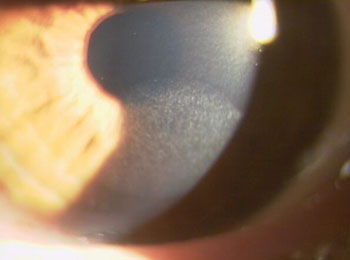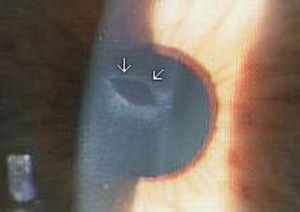Possible risks
During surgery several safety checks must be done when assembling the keratome and in the surgical procedure. Disposable monobloc keratomes will soon be available to simplify the procedure.
In very rare cases the flap may be incomplete or too small: the laser treatment must then be postponed for 3 months.
 |
 |
| Incomplete cut | Button hole |
There are two cases in which the flap must be reopened after the initial surgery: when folds appear in the flap in the days following the LASIK (because the patient has rubbed or squeezed his/her eyes) or when epithelial cells proliferate under the flap. This does not happen very often. Post-operative infections are even rarer.
Short period of dryness after Lasik treatment
Patients often develop dryness of the eyes, which can be prevented or treated with artificial tears. Some patients complain of haloes around headlights at night, especially when the myopia to be corrected is severe or the patient's pupils are large. This trouble is usually no more than temporary.
The high cost of the procedure is due to the price of the laser equipment and its maintenance costs.
DLK
DLK is a rare complication after Lasik surgery. The patient develops a haze under the Lasik flap, the so called interface. DLK is also called Sands of Sahara. The haze is caused by a response of the cornea to the presence of sterile foreign cells (infiltrates) in the flap interface. The complication usually occurs in the early post-operative period within one to six days after surgery, however, DLK has occurred months and years after surgery. The patient’s vision is hazy and the eye is painful and teary.
There is also an intolerance of bright light. In general DLK is treated by means of eye drops, for instance, cortisone drops. On very rare occasions it is necessary to lift the flap, remove some of the infiltrates and reposition the flap.
Keratectasia
Keratectasia is a progressive bulging of the cornea. This complication can occur for instance after a preceding surgery, for example lasik surgery. However, it is extremely rare for this complication to occur. The first symptoms appear within a few months to sometimes two years after the surgery. The patient’s vision will decline progressively, which is caused by an increasing irregular deformation of the cornea (astigmatism). Recently specialists have developed a treatment that stabilises this deformation, the ultra-violet-crosslinking (link website). When the deformation reaches an extreme, a cornea transplantation is necessary (link website). Keratectasia is a complication that can be avoided by a complete screening of the patients before a possible refractive surgery. This screening should look for fruste keratoconus, a deviation in the cornea that does not induce symptoms but can nevertheless be detected by means of elevation topography (Pentacam or Orbscan) (link website).
More about Lasik
Advantages
Possible risks
The operation
Preparing for an operation
History Lasik
If you want more information, or would like to make an appointment:
Contact us or call 0032 (0)2 741 69 99